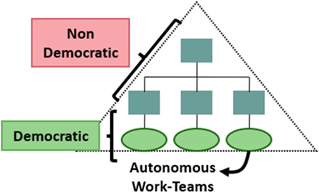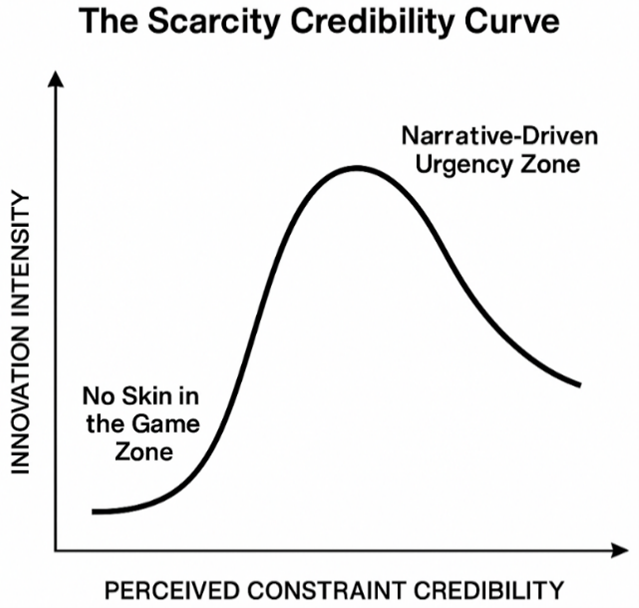
Publication Frequency
Quarterly
Journal Articles
Search
Search scope
Journal Center
Asia Pacific Academy of Science Pte. Ltd. (APACSCI) specializes in international journal publishing. APACSCI adopts the open access publishing model and provides an important communication bridge for academic groups whose interest fields include engineering, technology, medicine, computer, mathematics, agriculture and forestry, and environment.
Volume Arrangement
Featured Articles

Administration is an academic field that is showing signs of maturity, with a theoretical and practical mainstream that has been consolidated around Weberian bureaucracy, a management paradigm with numerous examples suggesting that it may be reaching its limits in terms of the new advances it can offer the discipline. On the other hand, the shift to a paradigm that transcends it (while retaining all its virtues) requires not only successful empirical counter-examples, but also a consistent alternative theoretical corpus that gives academics and especially practitioners the confidence to adopt it. In this sense, through “integrative” literature review-based research, the article intends to outline a scholarly narrative that provides concrete theoretical underpinnings to explain, in a systematic and concise manner, why management styles that depart significantly from bureaucratic orthodoxy are stable (i.e., do not diverge towards “chaos and anarchy”), while also proving effective and efficient. As a result of the analysis carried out, an intertwined combination of contributions about alternatives to the classical bureaucratic arrangement is obtained, sourced from studies of different time periods. Thence, based on four conceptual axes (self-actualization, objectives, capabilities and monitoring), the elaboration of a theoretically integrated explanation for the sustainable viability of participatory and horizontal management is achieved. This article’s contribution points towards the future possibility of consolidating novel approaches that virtuously supplant the current bureaucratic mainstream.

Many organizations try to spark innovation by imposing artificial constraints like tight deadlines or hackathons, hoping to replicate the ingenuity born of necessity. Yet research shows these often fall short. This article contrasts “authentic scarcity”, conditions of irreversible consequences and existential urgency, with artificially imposed constraints. Only the former reliably activates the psychological, cultural, and systemic drivers of transformative innovation. Through case studies of Mumbai’s Dharavi slum and Silicon Valley’s frugal innovation labs, we show how real constraints foster resilience and radical problem-solving, while artificial ones yield superficial creativity. We present a strategic framework for leaders to engineer purpose-driven missions with real stakes, collaborate with necessity-driven ecosystems, and cultivate high-stakes leadership. The paper concludes with a theory of authentic scarcity, explaining how genuine constraints uniquely drive breakthrough innovation by triggering focus, cohesion, and urgency, offering crucial insights for innovation management in resource-rich settings.
The application of big data analytics in sports as a tool for personalized fan experience, operations efficiency, and fan engagement strategy
Article ID: 3075
Vol 2, Issue 1, 2025
DOI: https://doi.org/10.54517/bmtp3075
Vol 2, Issue 1, 2025
Received: 18 November 2024; Accepted: 17 January 2025; Available online: 25 January 2025; Issue release: 31 March 2025
Download PDF
Abstract
In the contemporary sports industry, big data analytics [BDA] has become a cornerstone of marketing, fundamentally reshaping how sports organizations engage with their audiences by providing unprecedented opportunities for personalization and deeper fan connections. Sports organizations, by utilizing a diverse array of data sources, ranging from ticket sales and social media interactions to in-venue sensor data, can construct detailed profiles of their fanbase, facilitating highly targeted marketing strategies and personalized content that align closely with individual preferences and behaviors. This paper delves into the strategic deployment of BDA across the sports sector, emphasizing its role in customizing fan experiences, optimizing operational processes, and crafting immersive interactions that elevate fan engagement and loyalty. Adopting a theoretical approach, the research seeks to illuminate how BDA can be harnessed not only to boost fan engagement but also to streamline operational efficiencies. It further addresses the challenges and considerations that come with implementing these cutting-edge strategies and introduces a set of recommendations to successfully navigate the challenges. Through this exploration, the paper highlights the transformative impact of BDA on redefining fan interactions and engagement within the sports landscape. Ultimately, the paper underscores BDA’s transformative role in redefining fan interactions and engagement in sports, providing strategic insights for practitioners and suggesting paths for future research to further capitalize on this dynamic digital landscape.
Keywords
sports marketing; big data analytics [BDA]; personalized experience; operations efficiency; fan engagement strategies marketing strategies
References
- Schmidt SL. How Technologies Impact Sports in the Digital Age. In: Schmidt SL (editor). 21st Century Sports: How Technologies Will Change Sports in the Digital Age. Springer International Publishing; 2024. pp. 3–16.
- Chase C. The Data Revolution: Cloud Computing, Artificial Intelligence, and Machine Learning in the Future of Sports. In: Schmidt SL (editor). 21st Century Sports: How Technologies Will Change Sports in the Digital Age. Springer International Publishing; 2020. pp. 175–189.
- Watanabe NM, Shapiro S, Drayer J. Big Data and Analytics in Sport Management. Journal of Sport Management. 2021; 35(3): 197-202. doi: 10.1123/jsm.2021-0067
- Herberger TA, Dötsch JJ, eds. Digitalization, Digital Transformation and Sustainability in the Global Economy. Springer International Publishing; 2021.
- Wang Z. Research on Sports Marketing and Personalized Recommendation Algorithms for Precise Targeting and Promotion Strategies for Target Groups. Applied Mathematics and Nonlinear Sciences. 2024; 9(1). doi: 10.2478/amns-2024-1694
- Ogbuke NJ, Yusuf YY, Dharma K, et al. Big data supply chain analytics: ethical, privacy and security challenges posed to business, industries and society. Production Planning & Control. 2020; 33(2-3): 123-137. doi: 10.1080/09537287.2020.1810764
- Chi J. Big Data Classification of Personality Types Based on Respondents’ Big Five Personality Traits. Journal of Applied Data Sciences. 2022; 3(2): 89-101. doi: 10.47738/jads.v3i2.32
- Beatriz MF, Santos V. Stadium 2.0: Framework to Improve Sports Fans’ Experience in Stadium Through IoT Technology. In: Guarda T, Anwar S, Leon M, Mota Pinto FJ (editors). Information and Knowledge in Internet of Things. Springer International Publishing; 2022. pp. 229–247.
- Cappa F, Oriani R, Peruffo E, et al. Big Data for Creating and Capturing Value in the Digitalized Environment: Unpacking the Effects of Volume, Variety, and Veracity on Firm Performance*. Journal of Product Innovation Management. 2020; 38(1): 49-67. doi: 10.1111/jpim.12545
- Li W. Application of IoT-enabled computing technology for designing sports technical action characteristic model. Soft Computing. 2023; 27(17): 12807-12824. doi: 10.1007/s00500-023-08966-4
- Thudumu S, Branch P, Jin J, et al. A comprehensive survey of anomaly detection techniques for high dimensional big data. Journal of Big Data. 2020; 7(1). doi: 10.1186/s40537-020-00320-x
- Rawat R, Yadav R. Big Data: Big Data Analysis, Issues and Challenges and Technologies. IOP Conference Series: Materials Science and Engineering. 2021; 1022(1): 012014. doi: 10.1088/1757-899x/1022/1/012014
- Yiapanas G, Thrassou A, Vrontis D. The contemporary football industry: a value-based analysis of social, business structural and organisational stakeholders. Accounting, Auditing & Accountability Journal. 2023; 37(2): 552-585. doi: 10.1108/aaaj-06-2022-5855
- Faroukhi AZ, El Alaoui I, Gahi Y, et al. Big data monetization throughout Big Data Value Chain: a comprehensive review. Journal of Big Data. 2020; 7(1). doi: 10.1186/s40537-019-0281-5
- Mach-Król M. Conceptual Framework for Implementing Temporal Big Data Analytics in Companies. Applied Sciences. 2022; 12(23): 12265. doi: 10.3390/app122312265
- Xiao L, Li X, Zhang Y. Exploring the factors influencing consumer engagement behavior regarding short-form video advertising: A big data perspective. Journal of Retailing and Consumer Services. 2023; 70: 103170. doi: 10.1016/j.jretconser.2022.103170
- Holwerda JA. Big data? Big deal: Searching for big data’s performance effects in HR. Business Horizons. 2021; 64(4): 391-399. doi: 10.1016/j.bushor.2021.02.006
- Caulfield J, Jha AK. Stadiums and Digitalization: An Exploratory Study of Digitalization in Sports Stadiums. Journal of Decision Systems. 2022; 31(sup1): 331-340. doi: 10.1080/12460125.2022.2073629
- López-Carril S, Escamilla-Fajardo P, González-Serrano MH, et al. The Rise of Social Media in Sport: A Bibliometric Analysis. International Journal of Innovation and Technology Management. 2020; 17(06). doi: 10.1142/s0219877020500418
- McDonald H, Biscaia R, Yoshida M, et al. Customer Engagement in Sport: An Updated Review and Research Agenda. Journal of Sport Management. 2022; 36(3): 289-304. doi: 10.1123/jsm.2021-0233
- Mamo Y, Su Y, Andrew DPS. The transformative impact of big data applications in sport marketing: current and future directions. International Journal of Sports Marketing and Sponsorship. 2021; 23(3): 594-611. doi: 10.1108/ijsms-03-2021-0073
- Annamalai B, Yoshida M, Varshney S, et al. Social media content strategy for sport clubs to drive fan engagement. Journal of Retailing and Consumer Services. 2021; 62: 102648. doi: 10.1016/j.jretconser.2021.102648
- Xiong X. Study on the intelligent system of sports culture centers by combining machine learning with big data. Personal and Ubiquitous Computing. 2019; 24(1): 151-163. doi: 10.1007/s00779-019-01307-z
- Huettermann M, Uhrich S, Koenigstorfer J. Components and Outcomes of Fan Engagement in Team Sports: The Perspective of Managers and Fans. Journal of Global Sport Management. 2019; 7(4): 447-478. doi: 10.1080/24704067.2019.1576143
- Yiapanas G, Thrassou A, Vrontis D. Enhancing Sustainability Through Collaborative Value Creation in the Football Ecosystem. FIIB Business Review; 2024.
- Cai L, Zhao C, Wang X. Situation and lessons of application of NBA big data technology. IEEE; 2021.
- Abeza G, O’Reilly N, Nadeau J, et al. Big data in professional sport: the perspective of practitioners in the NFL, MLB, NBA, and NHL. Journal of Strategic Marketing. 2022; 31(8): 1413-1433. doi: 10.1080/0965254x.2022.2108881
- Baerg A. Quantification, Big Data, and Biometrics in Sport. Sport, Social Media, and Digital Technology. 2022; 15: 205-222. doi: 10.1108/s1476-285420220000015024
- Patel D, Shah D, Shah M. The Intertwine of Brain and Body: A Quantitative Analysis on How Big Data Influences the System of Sports. Annals of Data Science. 2020; 7(1): 1-16. doi: 10.1007/s40745-019-00239-y
- Bai Z, Bai X. Sports Big Data: Management, Analysis, Applications, and Challenges. lin chuan, ed. Complexity. 2021; 2021(1). doi: 10.1155/2021/6676297
- Ennis S. Ticketing Strategies in the Sports Sector. In: Ennis S (editor). Sports Marketing: A Global Approach to Theory and Practice. Springer International Publishing; 2020. pp. 153–185.
- Popham J, Lavoie J, Coomber N. Constructing a Public Narrative of Regulations for Big Data and Analytics: Results From a Community-Driven Discussion. Social Science Computer Review. 2018; 38(1): 75-90. doi: 10.1177/0894439318788619
- Ding J, Chen C, Yu K. (2021). Application Status and Prospect of Artificial Intelligence Big Data in Stadium Management. In: Huang C, Chan Y, Yen N (editors). 2020 International Conference on Data Processing Techniques and Applications for Cyber-Physical Systems. pp. Springer Singapore; 2021. 791–797.
- Yang C, Cole CL. Smart Stadium as a Laboratory of Innovation: Technology, Sport, and Datafied Normalization of the Fans. Communication & Sport. 2020; 10(2): 374-389. doi: 10.1177/2167479520943579
- Maheshwari S, Gautam P, Jaggi CK. Role of Big Data Analytics in supply chain management: current trends and future perspectives. International Journal of Production Research. 2020; 59(6): 1875-1900. doi: 10.1080/00207543.2020.1793011
- Himeur Y, Elnour M, Fadli F, et al. AI-big data analytics for building automation and management systems: a survey, actual challenges and future perspectives. Artificial Intelligence Review. 2022; 56(6): 4929-5021. doi: 10.1007/s10462-022-10286-2
- Zhu X, Kou F. Design and Implementation of Smart Stadium System Based on Internet Technology. IEEE; 2023.
- van Heck S, Valks B, Den Heijer A. The added value of smart stadiums: a case study at Johan Cruijff Arena. Journal of Corporate Real Estate. 2021; 23(2): 130-148. doi: 10.1108/jcre-09-2020-0033
- Ikegwu AC, Nweke HF, Anikwe CV, et al. Big data analytics for data-driven industry: a review of data sources, tools, challenges, solutions, and research directions. Cluster Computing. 2022; 25(5): 3343-3387. doi: 10.1007/s10586-022-03568-5
- Singh H. Big data, industry 4.0 and cyber-physical systems integration: A smart industry context. Materials Today: Proceedings. 2021; 46: 157-162. doi: 10.1016/j.matpr.2020.07.170
- Wang B, Wang Y. Big data in safety management: An overview. Safety Science. 2021; 143: 105414. doi: 10.1016/j.ssci.2021.105414
- Bajpai A, Bagchi A. Enhancement of Fans Experiences in Stadiums through better Facility Management. Annals of Tropical Medicine and Public Health. 2020; 23(17). doi: 10.36295/asro.2020.231702
- Yiapanas G, Thrassou A, Vrontis D. A holistic strategic perspective of football industry stakeholders. J for International Business and Entrepreneurship Development. 2022; 14(3): 349. doi: 10.1504/jibed.2022.126947
- Buser M, Woratschek H, Ridpath BD. Gamification through fantasy sports – Empirical findings from professional sport leagues. Sport, Business and Management: An International Journal. 2021; 11(5): 575-597. doi: 10.1108/sbm-08-2020-0080
- Pandita D, Vapiwala F. Waving the flames of fan engagement: strategies for coping with the digital transformation in sports organizations. Journal of Strategy and Management. 2023; 17(3): 427-443. doi: 10.1108/jsma-02-2022-0041
- Wilkins L. A bibliometric analysis of fantasy sports research. Entertainment Computing. 2024; 48: 100613. doi: 10.1016/j.entcom.2023.100613
- Bitrián P, Buil I, Catalán S. Gamification in sport apps: the determinants of users’ motivation. European Journal of Management and Business Economics. 2020; 29(3): 365-381. doi: 10.1108/ejmbe-09-2019-0163
- Chan G, Arya A, Orji R, et al. Increasing motivation in social exercise games: personalising gamification elements to player type. Behaviour & Information Technology. 2023; 43(11): 2608-2638. doi: 10.1080/0144929x.2023.2255293
- Raisinghani MS, Idemudia EC, Wang F. From Big Data to Big Insights: A Synthesis of Real-World Applications of Big Data Analytics. In: Mora M, Wang F, Marx Gomez J, Duran-Limon H (editors). Development Methodologies for Big Data Analytics Systems: Plan-driven, Agile, Hybrid, Lightweight Approaches. Springer International Publishing; 2024. pp. 263–277.
- Goes FR, Meerhoff LA, Bueno MJO, et al. Unlocking the potential of big data to support tactical performance analysis in professional soccer: A systematic review. European Journal of Sport Science. 2020; 21(4): 481-496. doi: 10.1080/17461391.2020.1747552
- Choi HS, Hung SY, Peng CY, et al. Different Perspectives on BDA Usage by Management Levels. Journal of Computer Information Systems. 2021; 62(3): 503-515. doi: 10.1080/08874417.2020.1858729
Supporting Agencies
Copyright (c) 2025 Author(s)
License URL: https://creativecommons.org/licenses/by/4.0/

This site is licensed under a Creative Commons Attribution 4.0 International License (CC BY 4.0).
Editor-in-Chief

Macau University of Science and Technology, Macau
Indexing & Archiving
News & Announcements
2025-07-06
Call for Papers | Volume 2 Issue 3
Business and Management Theory and Practice (eISSN: 3082-8155) is now inviting submissions from researchers, academics, and practitioners for consideration in our upcoming Volume 2 Issue 3, scheduled for publication in September 2025.
2025-07-04
Volume 2 Issue 2 (2025) Published Online - Tensions and Synergies Shaping Contemporary Organizations
We are pleased to announce the formal release of the second issue of Business and Management Theory and Practice (eISSN: 3082-8155) in 2025. This issue consists of six research articles and three review articles, and one editorial contributed by the editorial board member, Prof. Kai Wu.
2025-04-02
Volume 2 Issue 1 (2025) Released - Toward More Efficient Business Management
We would like to inform all of our readers of the formal release of the first issue of Business and Management Theory and Practice (eISSN: 3082-8155) in 2025. This issue consists of three research articles, five review articles, and one editorial from our respected editorial board member, Dr. Jian Xu, who has been recently selected into the 2024 Elsevier "Highly Cited Chinese Researchers" list.
2025-03-27
Good News! Dr. Jian Xu Included in the 2024 Elsevier “Highly Cited Chinese Researchers” List
We are pleased to announce that BMTP’s editorial board member, Dr. Jian Xu, has been selected into the 2024 Elsevier "Highly Cited Chinese Researchers" list. This is to acknowledge his significant contribution to the field of Applied Economics.
2025-01-15
Business and Management Theory and Practice Obtained Its ISSN: 3082-8155
We are pleased to share with all our contributors that our journal, Business and Management Theory and Practice received its eISSN (3082-8155), assigned by ISSN National Centre for Singapore. The journal is now collecting submissions for Volume 2 Issue 1. We encourage scholars to contribute to this journal.
2025-01-03
Launch of the Inaugural Issue of Business and Management Theory and Practice
We are delighted to announce the official release of the inaugural issue of Business and Management Theory and Practice. This issue features five insightful articles from esteemed authors based in Nigeria, China, Iran, and Cyprus.




.jpg)
.jpg)
